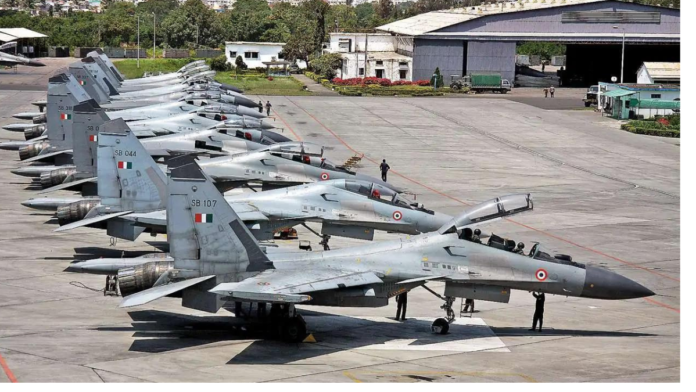India’s fleet of Su-30MKI fighter jets may eventually need to be replaced due to advancements in aerospace technology, even with planned modifications. The Super-Sukhoi, an upgrade intended to bring the Su-30MKI closer to the Su-35S’s capabilities, will still be limited in terms of infrared signature (IRS) and radar cross-section (RCS).
All of these things, together with the speed at which radars, surface-to-air missiles (SAMs), and air-to-air missiles (AAMs) are developing, highlight the necessity of developing next-generation aircraft that are effective against contemporary air threats.
Fighter planes of the fifth and sixth generations are outfitted with the newest technology to outperform opponents and are intended to function as “spies and snipers.” Although these sophisticated aircraft can be supplemented by older models, frontline fighters need to have the most recent stealth, sensors, and weapons.
Even after being upgraded to a Super-Sukhoi, the Su-30MKI would inevitably lag behind in these areas as opponents deploy increasingly sophisticated systems designed to fight fifth-generation aircraft.
An aircraft must undergo a generational leap in design and technology when its engine or airframe can no longer fulfill the demands of modern combat. It will take years of study and development to make this shift. The requirement for Europe to catch up to the United States in this area is reflected in its choice to forego the fifth generation and go straight to sixth-generation initiatives like the Future Combat Air System (FCAS) and Global Combat Air Programme (GCAP).
Developing a fifth-generation fighter aircraft is a critical milestone that India’s Advanced Medium Combat Aircraft (AMCA) project represents. Nevertheless, the AMCA program is moving slowly, much like the Light Combat Aircraft (LCA) program.
The absence of appropriate engines, whether produced domestically, obtained through partnerships, or imported, is one of the primary obstacles. The initiative runs the danger of delays and difficulties in the prototype phase without dependable engines to experiment with.
The difficulties in obtaining cutting-edge technology are highlighted by India’s decision to leave the PAK FA/FGFA deal with Russia because of a lack of technology transfer (ToT) on the Su-57. While there have been rumors of obtaining Su-57s as a temporary fix, this does not address the long-term requirement for a fifth- or sixth-generation fighter manufactured domestically.
While India’s fifth-generation fighter program confronts obstacles, its regional rivals are making notable progress. China is anticipated to field J-31/35 versions and has built a significant number of J-20 fighters. Like how the X-35 developed into the F-35, South Korea is ready to advance its capabilities with its KF-21 Boramae.
Even smaller nations, such as Sweden and Turkey, are making progress with their fighter aircraft programs. Sweden is currently examining its Flygsystem 2020 program before deciding to join GCAP or FCAS, while Turkey recently conducted its first flight with the Kaan.
The competition in the region may be further heightened if Pakistan tried to create a one-engine fighter to replace the JF-17 with China’s help. In light of these obstacles and advancements, India needs to strive to produce a fighter that is at least 5.5 generations old. Such an aircraft should be able to fulfill the needs of modern combat and have enough thrust and interior volume for new armaments, equipment, and fuel.
Because it uses its cannon for close quarters fighting and relies on a greater probability of kill (Pk) with less beyond-visual-range air-to-air missiles (BVR-AAMs), the AMCA may need to carry fewer weapons internally in its stealth version.
Although India’s slow progress in developing aerospace engines has created a bottleneck, there is yet hope. Funds for engine development must be approved by the nation, whether they come from imports, joint ventures, or the Gas Turbine Research Establishment (GTRE). Future advanced heavy jets, the AMCA, the Medium Weight Fighter (MWF), and the Twin Engine Deck-Based Fighter (TEDBF) will all require these engines.
There is room for cooperation with ISRO even though organizations like the National Aerospace Laboratories (NAL), the Aeronautical Development Agency (ADA), and the DRDO are overburdened with current programs. Significant advancements in avionics and materials science made by the space agency may help build variable cycle engines and other cutting-edge technology.
Ever since the inception of prototypes such as the T-10 and sophisticated aircraft like the MiG-25 and F-15, it is certain that Indian scientists and engineers have envisioned producing a domestically produced jet of comparable quality. It is more important than ever to use the resources at hand to continue research and development. It would take decades for India to catch up to Western standards of quality, but with consistent improvement, it can do so.
Also Read: DRDO to start Phase-III of ballistic missile defence shield for India
India needs to concentrate on creating a fighter jet that can withstand the strains of contemporary combat as it looks to the future. The Su-30MKI fleet’s lifespan will be increased by the Super-Sukhoi upgrade, but the ultimate objective should be the creation of a fighter that is 5.5 generations or more advanced. India is able to guarantee its position in the future generation of air superiority by utilizing its own expertise, working with organizations such as ISRO, and obtaining the required capital and technology.



